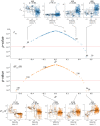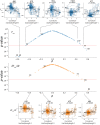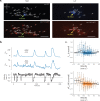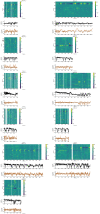Decoding locomotion from population neural activity in moving C. elegans
- PMID: 34323218
- PMCID: PMC8439659
- DOI: 10.7554/eLife.66135
Decoding locomotion from population neural activity in moving C. elegans
Abstract
We investigated the neural representation of locomotion in the nematode C. elegans by recording population calcium activity during movement. We report that population activity more accurately decodes locomotion than any single neuron. Relevant signals are distributed across neurons with diverse tunings to locomotion. Two largely distinct subpopulations are informative for decoding velocity and curvature, and different neurons' activities contribute features relevant for different aspects of a behavior or different instances of a behavioral motif. To validate our measurements, we labeled neurons AVAL and AVAR and found that their activity exhibited expected transients during backward locomotion. Finally, we compared population activity during movement and immobilization. Immobilization alters the correlation structure of neural activity and its dynamics. Some neurons positively correlated with AVA during movement become negatively correlated during immobilization and vice versa. This work provides needed experimental measurements that inform and constrain ongoing efforts to understand population dynamics underlying locomotion in C. elegans.
Keywords: C. elegans; behavior; calcium imaging; decoding; locomotion; neural dynamics; neuroscience; physics of living systems; population code.
© 2021, Hallinen et al.
Conflict of interest statement
KH, RD, MS, XY, AL, FR, AS, JS, AL No competing interests declared
Figures






















References
Publication types
MeSH terms
Grants and funding
LinkOut - more resources
Full Text Sources
Research Materials

